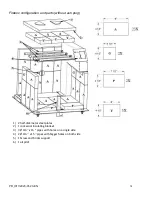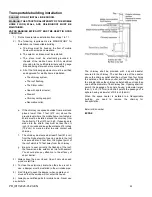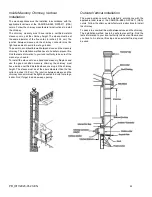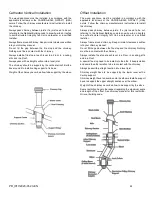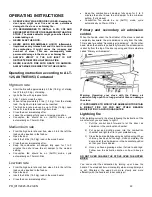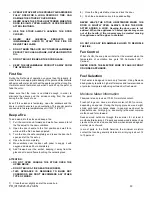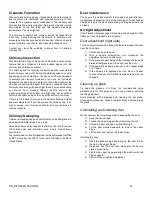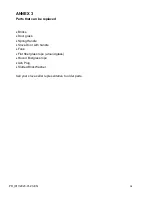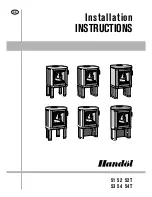
PR_I017/2023-01-23-EN
23
Chimney installation, General steps
Use only approved chimneys, the same size as the output
collar, 6 inches in this case. The chimneys used must be tested
according to CAN/ULC S629 M87 in
Canada and to UL 103 (type HT) in USA.
The stove can be install with a masonry
chimney according to ULC S635, ULC
S640 and UL 1777. The masonry chimney
must be equipped with a stainless steel
sleeve and meet the standards for the
masonry chimney with inner sleeve.
Provide a place to sweeping.
It is preferable, if possible, to avoid an
outside chimney or built on an exterior wall,
and this is even more important for colder
areas. Outside chimneys generally have a
less efficient draught. They can even have
an inverse draught because it is hard to
heat them enough so that they can reach
their operating temperature. A greater
accumulation of creosote, a less efficient
draught and a lesser performance are
some characteristics of cold chimneys.
Draught is proportional to the total chimney height as well as its
temperature. It is therefore possible to get a better draught by
increasing the chimney's height and by reducing the heat loss
with an insulated lining. The chimney has to be installed with a
stainless steel lining. Make sure that all smoke pipe joints are
really airtight. A leak reduces the efficiency of the appliance and
could even make its utilization dangerous. Using a high
temperature silicon or cement to ensure that the smoke pipe
joint are airtight. If the chimney pass through the exterior wall or
insulated roof be sure the hole after installation needs to be
airtightness. Use sealant to make the building airtight.
Note: This is a general chimneys installation method.
Always refer to the manufacturer’s manual of the chimney
for a more detailed method for your chimney.
1) Determine the total length needed for your chimney.
2) Cut the holes into all floor and roof
3) If you need to cut a joist, be sure to strengthen the
adjacent joists and frame hole respecting the minimum
dimensions to be maintained between combustible
materials and the firewall. Follow the manufacturer's
instructions in the manual supplied with the firestop.
Never cut a structural beam.
4) Frame the holes in each level and attic respecting the
minimum
distance
recommended
by
the
manufacturer's manual of your chimney.
5)
Install firestop in each level
.
6) Frame the hole into the roof.
7) Install the chimney support at the ceiling where stove
is installed.
8) Stack and lock the factory built chimney section on the
support and above the roof.
•
The chimney must be over 36 inches (91.4
cm) over the higher point into the roof
opening.
•
The chimney must also be 24 inches over the
highest point on the roof inside 10 ft (304 cm)
radius around chimney.
•
The minimum length of chimney is 12 feet
(365.8 cm).
ATTENTION: Be sure the chimney section are locked
together and locked onto the chimney support.
NOTE: More lengthen chimney than the minimum can add
more draft and help to the good working operation of the
stove Try the minimum length first then add section if you
need more draft.
9) Put the roof flashing over the chimney and seal it with
roof caulking.
10) Nail roof flashing, and reinstall roof covering.
11) Slide the storm collar over the chimney and seal it with
high temperature caulking.
12)
Lock the chimney cap and install the spark arrestor if
necessary
Note:
•
Chimney performance may vary.
•
Buildings, trees, roof line and wind conditions affect
performance, and can make backflow into the
chimney.
•
Chimney height may need adjustment if smoking or
overdraft occurs.
Summary of Contents for PIONEER
Page 4: ...PR_I017 2023 01 23 EN 4 RATING PLATE...
Page 5: ...PR_I017 2023 01 23 EN 5 APPLIANCE DIMENSION...
Page 6: ...PR_I017 2023 01 23 EN 6...
Page 7: ...PR_I017 2023 01 23 EN 7...
Page 34: ...PR_I017 2023 01 23 EN 34 ANNEX 1 Exploded diagram of door Arc door...
Page 35: ...PR_I017 2023 01 23 EN 35 ANNEX 2 Fans electric wiring diagram...










